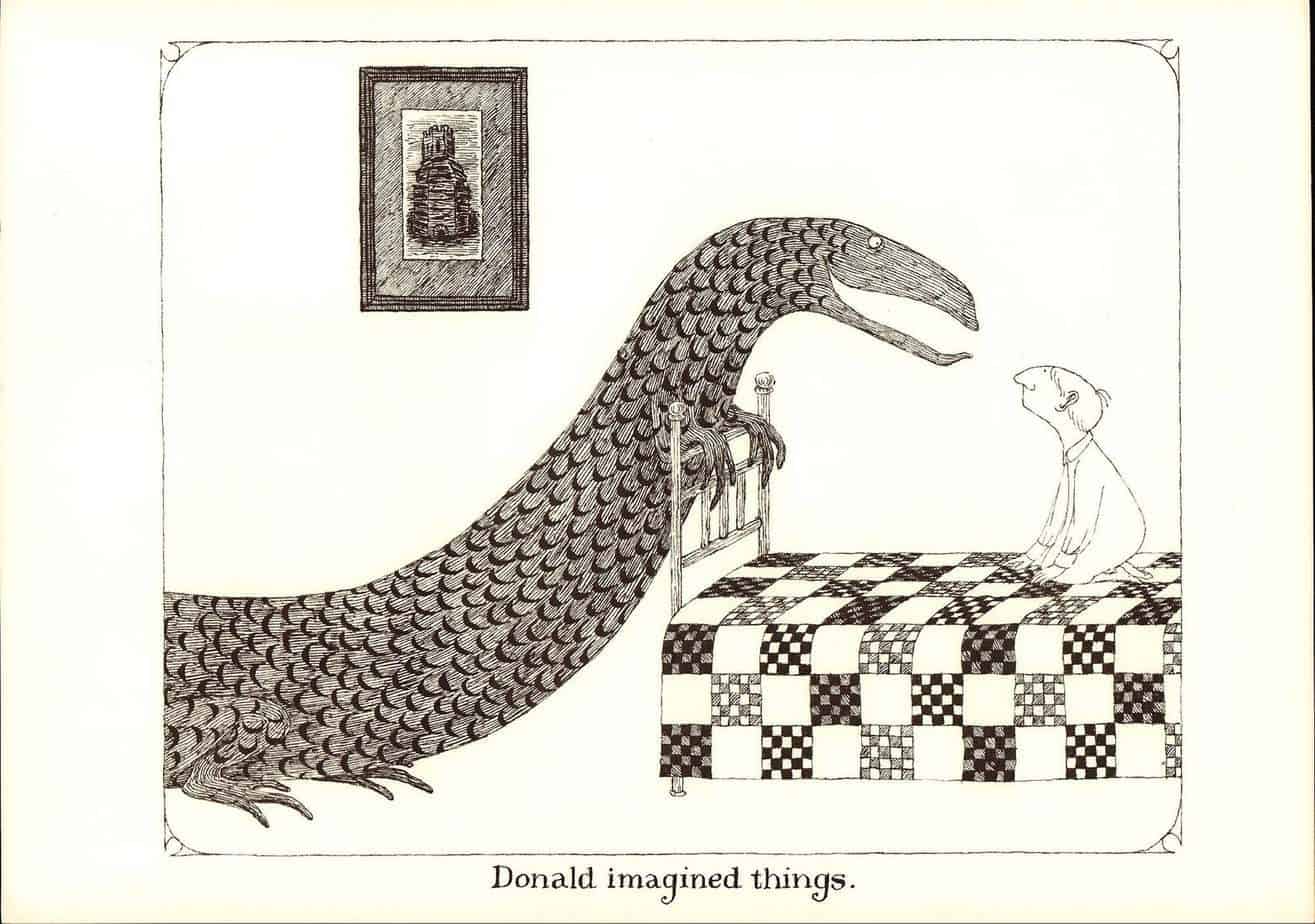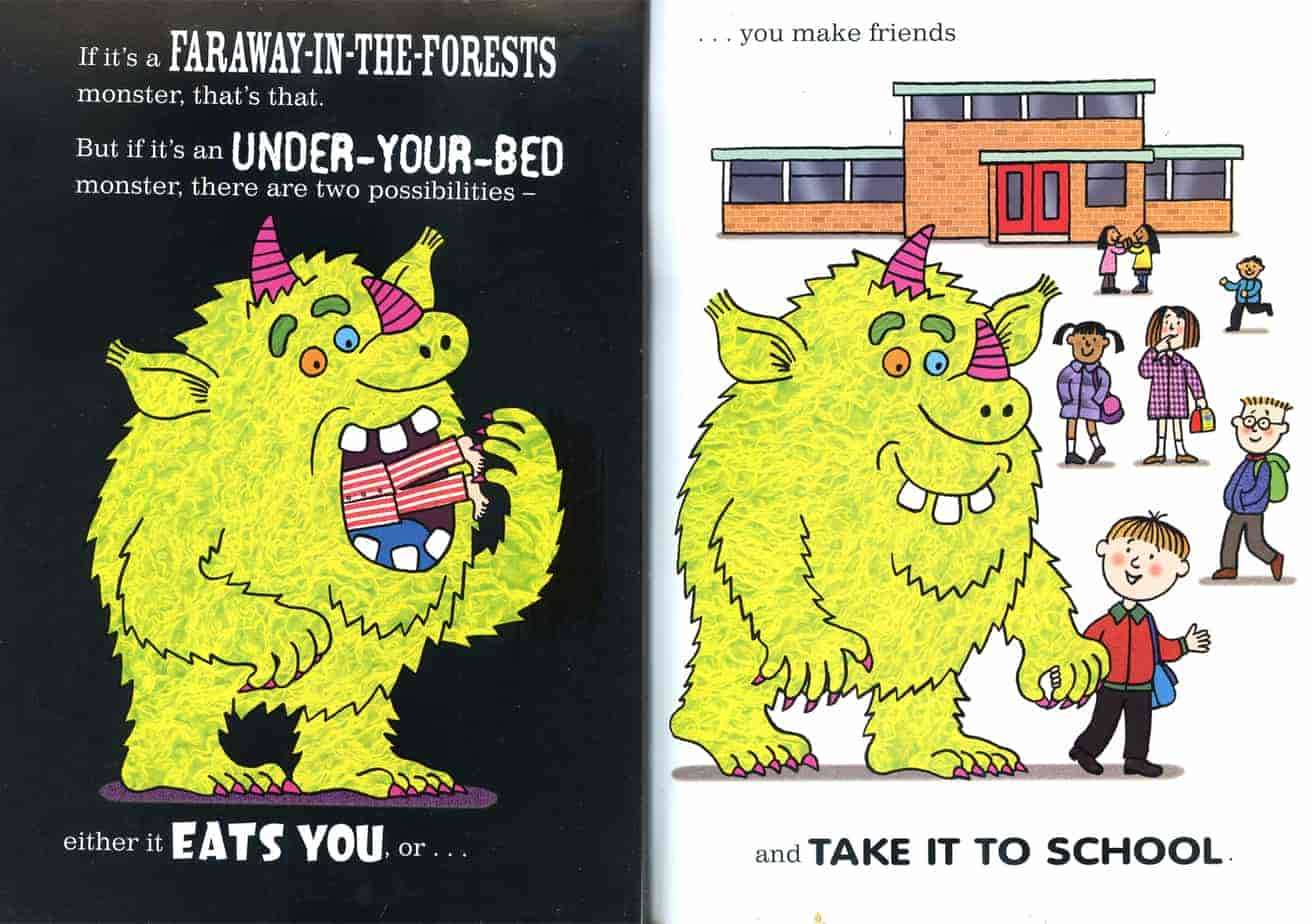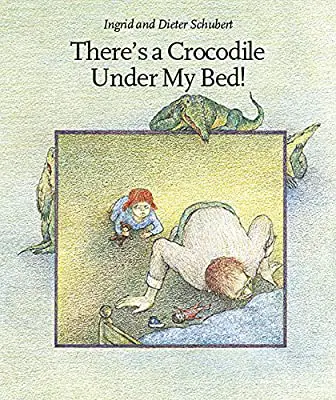There’s A Crocodile Under My Bed! is a picture book written and illustrated by Ingrid and Dieter Schubert. First published in 1980, that makes this classic forty years old. There are a large number of picture books about creatures lurking under beds, and many similar titles out there. The most widely known is Mercer Meyer’s There’s An Alligator Under My Bed (1987). The titles are similar but the plots are different.
There’s A Crocodile Under My Bed is an interesting example of a carnivalesque story which serves a purpose other than having fun: A child learns to overcome her fears. So I’ll be looking at this book according to a carnivalesque structure.
I’m not entirely sure about cause and effect when it comes to Monsters-Under-Beds stories. Which come first: All these picture books urging kids not to worry about monsters under the bed, or nightmares about monsters under the bed? Also, if this is such a common fear, why ask kids to sleep in beds with gaps underneath? I grew up on a divan, and I wonder if this is why I never had this particular fear. The other issue with gaps under kids’ beds: They tend to fill up with toys and clothes and other essential items.
PARATEXT
Alongside Monster! which later became Monster Pet! this is another example of a picture book which has had a title change, just minor this time: “There’s” >> “There is”. Apparently the story has been rewritten and it’s interesting to see how:
Since the publication of There Is a Crocodile under My Bed! in 1980, countless children have overcome their fears of the dark with this ever-selling picture book. But times have changed and Ingrid and Dieter Schubert changed too. So they proudly present a totally renewed There Is a Crocodile under My Bed! The girl who discovers a crocodile under her bed thinks: This is going to be fun! She decides to tame the beast with her hoop and that’s the beginning of a special friendship. The new artwork by Ingrid and Dieter Schubert is as firm and fearless as the protagonist herself. With powerful simple prints without superfluous words, they tell the story that will take young readers to bed with self-confidence at least for the next thirty-five years!”
marketing copy
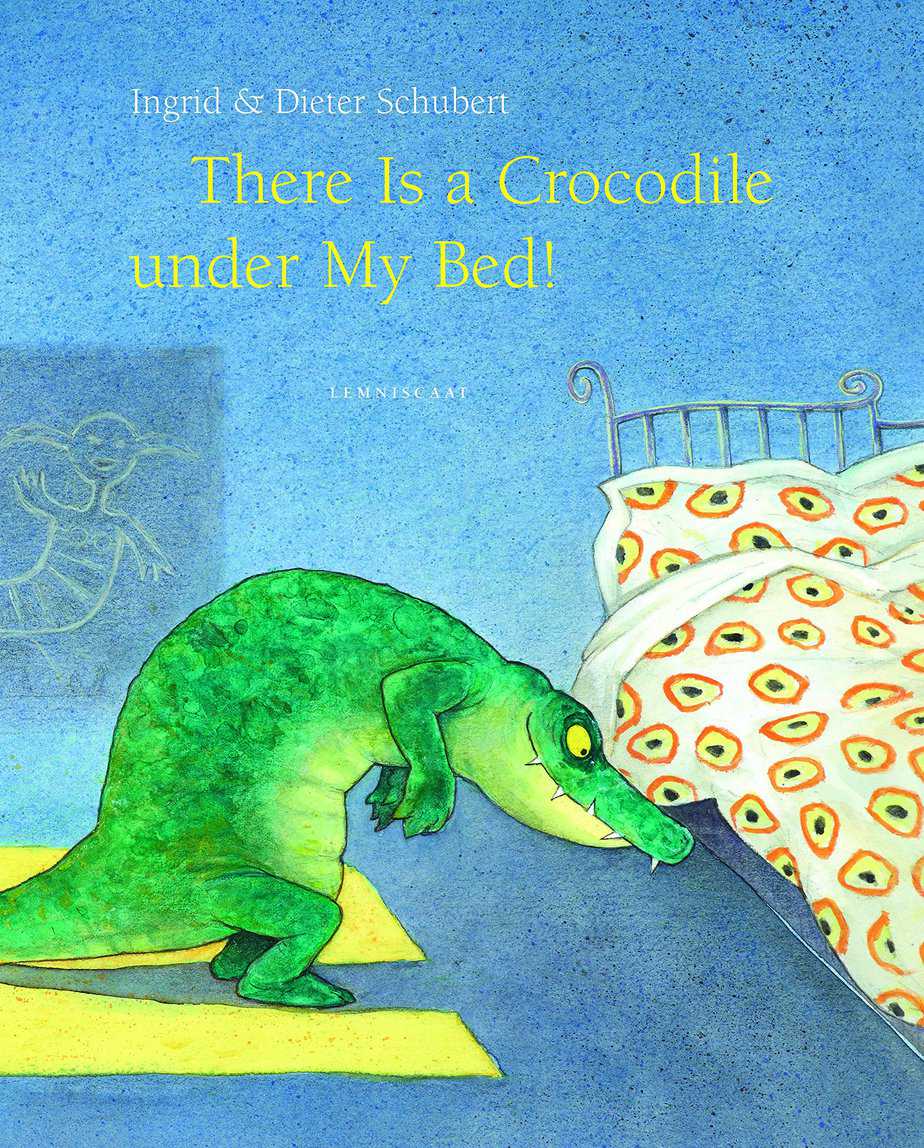
Unfortunately I only have my hands on the pre-2015 version so can’t do a compare and contrast. The marketing copy suggests the little girl has been turned into a Strong Female Character archetype who tames beasts.
In this 1980 version in front of me, it’s clear how wordy it is compared to the modern picture book, normally around 300-400 words. So I wonder if the word count has been decreased as well.
CARNIVALESQUE STRUCTURE OF “THERE’S A CROCODILE UNDER MY BED!”
An Every Child is at home. There are commonly two children, a boy and a girl. Or maybe just one, especially if the child’s shortcoming is loneliness and isolation.
Peggy’s parents are going out. Presumably a human babysitter arrives, but that person is left off the page. Peggy is clearly scared that her parents are about to abandon her with someone she doesn’t know.
The Every Child wants to have fun. They commonly start in a place of restriction or boredom.
In this case, Peggy is not bored so much as scared. The crocodile appears as soon as her father leaves the room.
Appearance of an Ally in Fun. (The ‘Cat in the Hat‘ turns up; the ‘Tiger’ comes to tea.)
My reading is that the crocodile IS the babysitter. (But does the babysitter have a bath with her?) The crocodile proves his benign nature by offering to shrink to the size of a toy. Peggy refuses because if he’s bigger they can play.
Fun ensues. Hierarchy is completely overturned. The adults are no longer in charge!
The crocodile leads Peggy in a series of fun activities: bubble bath, rough and tumble, dancing, and then the creation of an egg-carton crocodile — every preschooler’s rite of passage (similar to the pasta art). This page includes instructions on how to make one, turning this into a story-craft how-to combo.
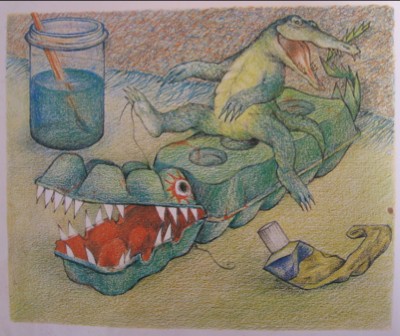
Fun culminates!
At this point the crocodile tells a story (a story within a story — the crocodile is now the hypodiegetic narrator. He tells Peggy about his adventures in the jungle, and how he dresses as a monster to frighten the other beasts. This provides The Big Struggle scene for the story as a whole.
The message for the young reader at this point: If the crocodile seems scary, that’s only because he’s pretending. Storytellers for young children seem to like this idea lot and I’m reminded of the episode of Peppa Pig which was banned in Australia for trying to persuade children that spiders are harmless. The idea that crocs are harmless is another message not ideal for Australian children, especially those who live in croc territory.
Peak Fun! Somehow the author must think of a way for the fun to get wackier and wackier. The best carnivalesque stories are displays of imagination even beyond a child’s wildest dreams. The carnivalesque story takes the reader beyond what they can imagine themselves.
In this embedded narrative, Henry the crocodile tells a story about why he was sent to the Land of Men to comfort children afraid of the dark. (It’s his penalty for behaving as a trickster with eggs.) This part of the story has the air of a porquoi tale for kids who might want to know why fantasy creatures turn up in their rooms at night.
Meanwhile, Peggy sits passively and listens to his convoluted speech. I wonder if this portion of the book has been revised to make Passive Peggy more involved.
In this 1980 version, the crocodile is so boring he has lulled Peggy to sleep. I do wonder if this is the point of the embedded narrative. There’s A Crocodile Under My Bed is certainly marketed as a going-to-bed book.
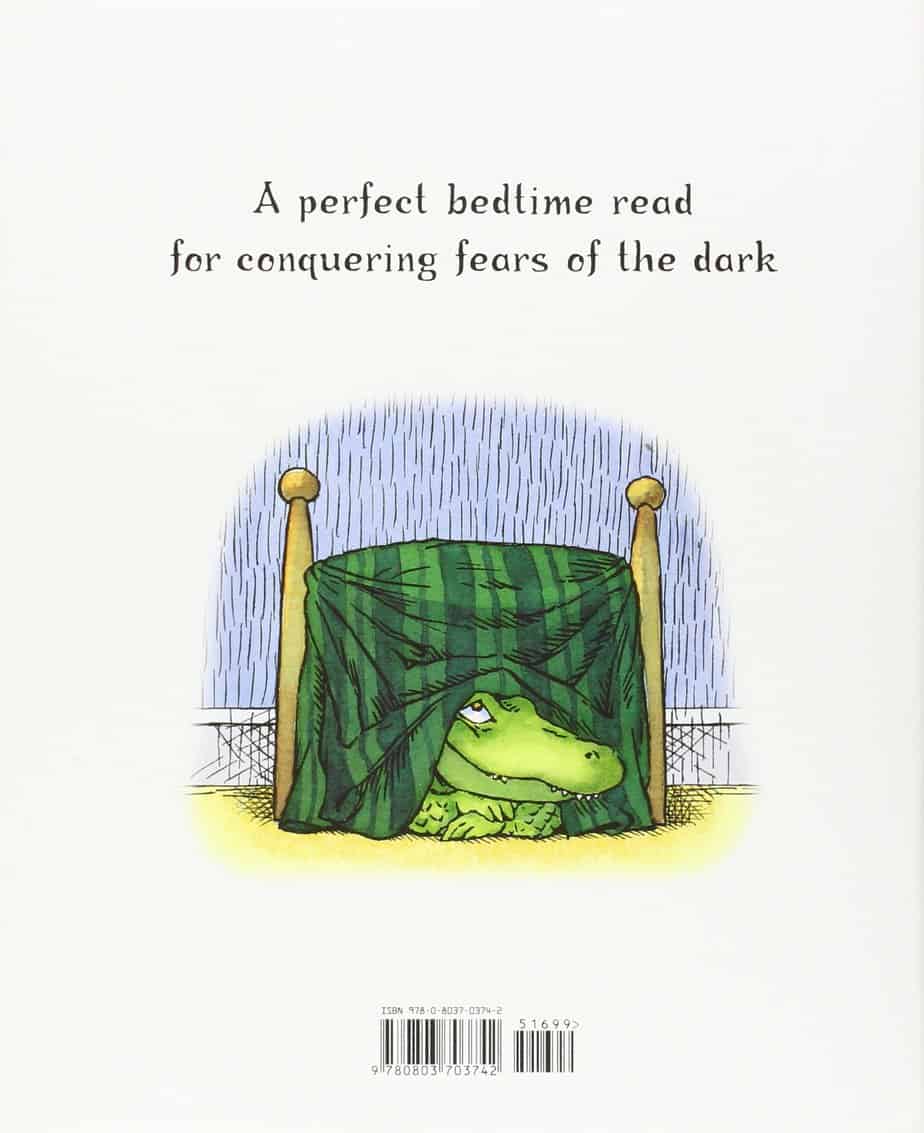
Return to the Home state. Normal and safe hierarchy resumes, with adults in charge.
The crocodile disappears and the last we see of him is his tail.
When Peggy wakes up it is morning and her parents are home. The father finds a crocodile under Peggy’s bed, suggesting some of the magic is real, except unlike The Polar Express, in which this ‘next day discovery’ proves the existence of magic, the crocodile is simply cardboard.
NOTES ON THE ILLUSTRATION
Light-handed coloured pencil work on toothy paper often signals a retreat into the character’s imagination, because the ‘haziness’ of the image mimics conceptually the ‘daydream’ state.
The crocodile is depicted as an expressive actual crocodile but with wonderfully evocative movement, as if it’s had dance training. Though the crocodile could be any gender, the ‘he’ pronoun genders him for us. Interesting to see the little girl and the male, much larger crocodile in the bath together. I think that image, if anything, dates the book. Adult audiences feel more protective of children now.
It’s very difficult to write a Monster Under The Bed picture book because it has been done so many times before.
